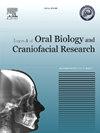Alginate-hydroxyapatite scaffolds: A comprehensive characterization study
Q1 Medicine
Journal of oral biology and craniofacial research
Pub Date : 2025-03-24
DOI:10.1016/j.jobcr.2025.03.010
引用次数: 0
Abstract
Introduction
Alginate has garnered significant attention in regenerative dentistry for its biocompatibility, mechanical strength, and controlled biodegradability. The incorporation of hydroxyapatite enhances its ability to mimic the dentin extracellular matrix, promoting cellular adhesion, proliferation, and mineralization. This study aims to comprehensively assess the structural, chemical, and biological properties of Alg-HA scaffolds to evaluate their potential for dentin regeneration.
Methods
Alginate-hydroxyapatite (Alg-HA) scaffolds were synthesized by dissolving sodium alginate (2 % w/v) in distilled water, followed by the incorporation of hydroxyapatite (HA) synthesized via chemical precipitation using calcium nitrate tetrahydrate and ammonium phosphate. The composite solution was homogenized through stirring and ultrasonication before being freeze-dried to fabricate porous scaffolds. Characterization was performed using X-ray Diffraction (XRD) to confirm crystallinity, Fourier Transform Infrared Spectroscopy (FTIR) to verify functional group interactions, and Scanning Electron Microscopy (SEM) with Energy Dispersive X-ray Analysis (EDAX) to analyze morphology and elemental composition. In vitro degradation studies were conducted in simulated body fluid (SBF) to assess scaffold stability by measuring mass loss over time, with additional pH monitoring and SEM analysis for morphological changes. Hemocompatibility was evaluated through hemolysis assays, comparing scaffold-incubated blood samples to positive and negative controls.
Results
XRD analysis confirmed the successful incorporation of HA within the alginate matrix, highlighting characteristic HA peaks and alginate's amorphous nature. FTIR analysis validated the composite formation through phosphate-carboxylate interactions. SEM imaging revealed a porous, interconnected structure with embedded HA particles, facilitating cell attachment and proliferation. EDAX confirmed the presence of calcium, phosphorus, and oxygen as primary constituents. In vitro degradation studies showed controlled degradation, with 80 % mass loss by day 3, indicating the composite's suitability for gradual tissue replacement. Hemocompatibility tests revealed minimal hemolysis (<2 %), confirming the composite's excellent blood compatibility.
Conclusion
The findings emphasize the potential of Alg-HA scaffolds for dentin regeneration. Their porous architecture, combined with embedded HA, enhances mechanical stability while providing essential biochemical cues for cell proliferation and mineralization. The demonstrated hemocompatibility ensures safe application in direct blood contact, reducing immune responses and promoting tissue integration. Compared to previous studies, this research offers a more in-depth understanding of the relationship between porosity, mineralization, and cellular behavior. Alginate-hydroxyapatite scaffolds exhibit excellent structural, chemical, and biological properties, making them promising candidates for regenerative dentistry. With excellent degradation, hemocompatibility, and ability to support cellular functions, these scaffolds hold significant potential for clinical applications, with further optimization paving the way for broader medical adoption.
海藻酸-羟基磷灰石支架:综合表征研究
海藻酸盐因其生物相容性、机械强度和可生物降解性而在再生牙科领域引起了广泛的关注。羟基磷灰石的掺入增强了其模拟牙本质细胞外基质的能力,促进细胞粘附、增殖和矿化。本研究旨在全面评估海藻酸钙支架的结构、化学和生物学特性,以评估其在牙本质再生方面的潜力。方法将海藻酸钠(2% w/v)溶解于蒸馏水中,然后将化学沉淀法合成的羟基磷灰石(HA)掺入四水硝酸钙和磷酸铵中,制备盐酸盐-羟基磷灰石(HA)支架。将复合溶液经搅拌、超声均质后冷冻干燥制备多孔支架。表征采用x射线衍射(XRD)确认结晶度,傅里叶变换红外光谱(FTIR)验证官能团相互作用,扫描电子显微镜(SEM)与能量色散x射线分析(EDAX)分析形貌和元素组成。在模拟体液(SBF)中进行体外降解研究,通过测量随时间的质量损失来评估支架的稳定性,并进行额外的pH监测和扫描电镜分析形态学变化。通过溶血试验评估血液相容性,将支架培养的血液样本与阳性和阴性对照进行比较。结果xrd分析证实了海藻酸盐基质中HA的成功结合,突出了HA峰的特征和海藻酸盐的无定形性质。FTIR分析证实了磷酸盐-羧酸盐相互作用形成的复合物。扫描电镜成像显示了一个多孔的、相互连接的结构,其中嵌入了HA颗粒,促进了细胞的附着和增殖。EDAX证实了钙、磷和氧是主要成分。体外降解研究表明,降解可控,第3天质量损失80%,表明该复合材料适合逐渐进行组织替代。血液相容性测试显示溶血最小(2%),证实该复合材料具有优异的血液相容性。结论本研究结果强调了Alg-HA支架在牙本质再生中的潜力。它们的多孔结构与嵌入的透明质酸相结合,增强了机械稳定性,同时为细胞增殖和矿化提供了必要的生化线索。演示的血液相容性确保安全应用于直接血液接触,减少免疫反应和促进组织整合。与以往的研究相比,本研究对孔隙度、矿化和细胞行为之间的关系有了更深入的了解。藻酸盐-羟基磷灰石支架具有良好的结构、化学和生物学特性,是再生牙科的理想材料。这些支架具有良好的降解性、血液相容性和支持细胞功能的能力,具有巨大的临床应用潜力,进一步优化将为更广泛的医疗应用铺平道路。
本文章由计算机程序翻译,如有差异,请以英文原文为准。
求助全文
约1分钟内获得全文
求助全文
来源期刊

Journal of oral biology and craniofacial research
Medicine-Otorhinolaryngology
CiteScore
4.90
自引率
0.00%
发文量
133
审稿时长
167 days
期刊介绍:
Journal of Oral Biology and Craniofacial Research (JOBCR)is the official journal of the Craniofacial Research Foundation (CRF). The journal aims to provide a common platform for both clinical and translational research and to promote interdisciplinary sciences in craniofacial region. JOBCR publishes content that includes diseases, injuries and defects in the head, neck, face, jaws and the hard and soft tissues of the mouth and jaws and face region; diagnosis and medical management of diseases specific to the orofacial tissues and of oral manifestations of systemic diseases; studies on identifying populations at risk of oral disease or in need of specific care, and comparing regional, environmental, social, and access similarities and differences in dental care between populations; diseases of the mouth and related structures like salivary glands, temporomandibular joints, facial muscles and perioral skin; biomedical engineering, tissue engineering and stem cells. The journal publishes reviews, commentaries, peer-reviewed original research articles, short communication, and case reports.
 求助内容:
求助内容: 应助结果提醒方式:
应助结果提醒方式:


